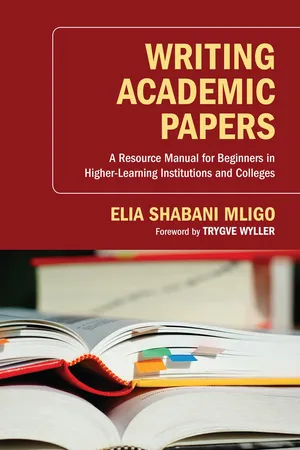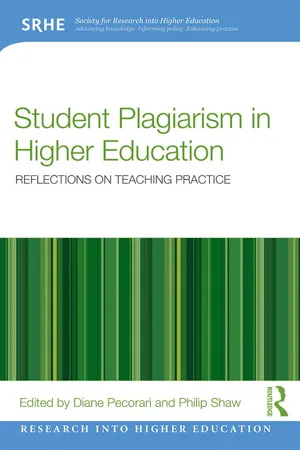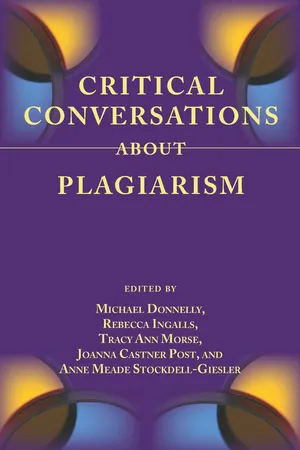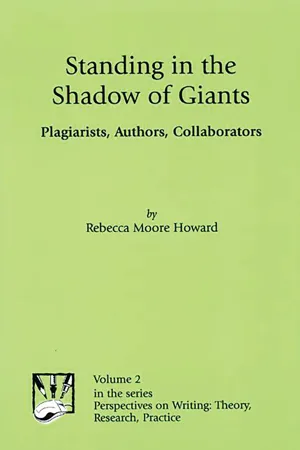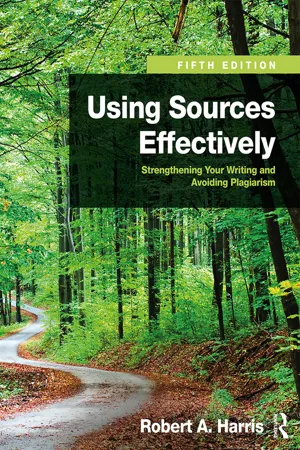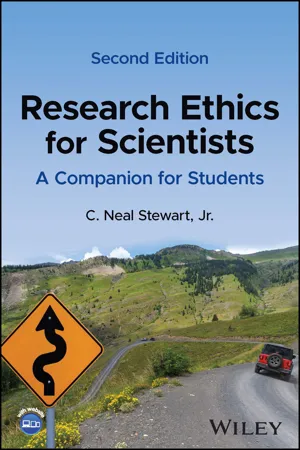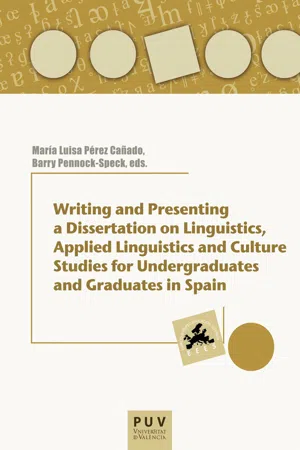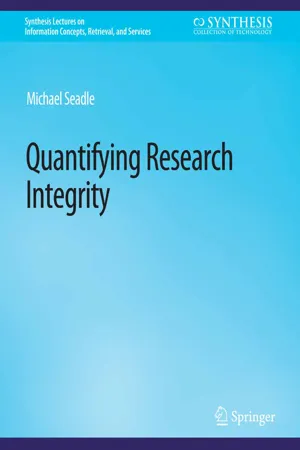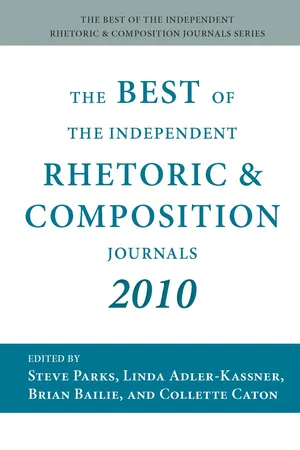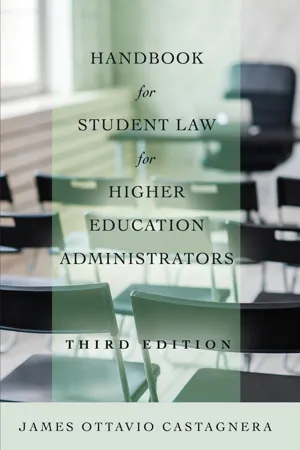Computer Science
Computer Plagiarism
Computer plagiarism refers to the act of using computer technology to copy or reproduce someone else's work without proper attribution. This can include copying code, algorithms, or other digital content without permission. It is a serious ethical and legal issue in the field of computer science, as it undermines the principles of academic integrity and intellectual property rights.
Written by Perlego with AI-assistance
Related key terms
1 of 5
12 Key excerpts on "Computer Plagiarism"
- eBook - ePub
Writing Academic Papers
A Resource Manual for Beginners in Higher-Learning Institutions and Colleges
- Mligo(Author)
- 2012(Publication Date)
- Resource Publications(Publisher)
5 According to the definitions above, plagiarism is mostly intentional. It is an intention of the writer to purloin someone’s ideas or written text and make it his/her own. However, these definitions are not exhaustive. We will continue defining it, with the help of some examples, depending on the type of plagiarism committed by the writer.As serious the misconduct is, plagiarism has caused many to face serious measures: some students have been dismissed from their schools as a result of presenting whole or part of works that were previous presented by other students for the same requirements or have just cut and pasted materials from the internet and made theirs, some workers have been chased out of their job positions because they have used other people’s words in reports or speeches without acknowledging, some professionals have been rejected promotions because of submitting the same book in several occasions for promotions or some salary increments, degrees and honors of some graduates have been rescinded as a result of this ethical misconduct.At this point we kindly warn students in higher-leaning institutions and colleges who are used to stealing part or whole materials from already presented papers and re-presenting them as their own to stop such academic ethical misconduct. In fact, it is better obtaining low mark in one’s paper while adhering to prescribed writing ethical conducts rather than attempting theft and falling into serious measures!Types of PlagiarismAfter stating briefly what plagiarism is, we now have to examine what constitutes plagiarism. Plagiarism manifests itself in various occasions and is not only limited to students’ papers. Plagiarism can also appear in books, in published articles, in music, in public speeches, and in other various written reports and proposals. In all these aspects, one person takes someone else’s ideas or text and uses them as his/her own without acknowledging the source. Roig identifies two types of plagiarism: plagiarism of ideas and plagiarism of text. - eBook - ePub
Student Plagiarism in Higher Education
Reflections on Teaching Practice
- Diane Pecorari, Philip Shaw, Diane Pecorari, Philip Shaw(Authors)
- 2018(Publication Date)
- Routledge(Publisher)
A further study (Pecorari & Shaw, 2012) used a judgement-elicitation task for a different purpose. Rather than testing whether respondents were capable of recognizing plagiarism, the purpose of this study was to discover to what extent academics held a shared understanding of it. A small number of experienced university teachers at a range of academic ranks were shown authentic writing samples and their sources, and asked to comment, in an interview setting, on whether they were appropriate, and if not, whether they were plagiarized. Because they usually found these determinations difficult, as they discussed their way forward to an answer, they voiced, in effect, the criteria they were applying, and the same six features arose in their comments. They needed to satisfy themselves about whether there was evidence of appropriation from the putative source and they did so by considering both qualitative and quantitative similarities, as well as the nature of the repeated material. That is, if it was so general or well known that it could be found in many places, coincidence rather than copying was a reasonable explanation. If they believed that there was a specific source, then they considered how clearly the students had identified the intertextual relationship by means of citations, quotation marks, etc. These factors were used both to help them decide whether the usage was appropriate, and to assess whether the students had intended to cheat.From the discussion above, it appears that it is possible to identify six fairly uncontroversial components of a definition of plagiarism. Taking them as a starting point, I would like to propose the following definition.Plagiarism is a form of academic misconduct involving a writing process which results in an inappropriate relationship between the new text and its source(s). Specifically, plagiarism involves a writer re-using propositional content and/or form of expression from another text without adequately signalling that relationship to the reader, and with an intention to mislead the reader about that relationship.Testing the definition of plagiarism
At the beginning of this chapter I argued that a good definition of plagiarism should meet three criteria: it should not admit counter-examples; it should have face validity; and it should be functional. In this section I will test how well the proposed definition meets each of these criteria. - eBook - PDF
- Michael Donnelly, Rebecca Ingalls(Authors)
- 2012(Publication Date)
- Parlor Press, LLC(Publisher)
(“Plagiarism and Copyright”) Using this definition as a starting point, there are several distinctions that I’ll parse so that we can better understand the differences be-tween the two: the offense of copying ideas vs. copying the expression of those ideas, the practice of attribution, and institutional vs. legal ramifications. Copying Ideas vs. Expression The first and most fundamental distinction to be made between pla-giarism and copyright is what type of copying constitutes each ac-tivity. Plagiarizing a text and committing copyright infringement of that same work may not result from the same behavior. This disparity arises because plagiarism policies and copyright law protect different things. Plagiarism policies are designed to protect the academic in-tegrity of the classroom and the university; they attempt to prevent cheating. Copyright law, on the other hand, is designed to protect the exclusive rights of authors to seek rewards from copying, distributing, and performing works they’ve created; it attempts, primarily, to pro-tect a vibrant and dynamic economic market of creative production. Definitions of plagiarism are specific to individual academic insti-tutions and sometimes to departments or units within a given institu-tion. Here is the definition of plagiarism at my institution, Northern Illinois University, which I believe is typical of many definitions: “Stu-dents are guilty of plagiarism, intentional or not, if they copy mate-rial from books, magazines, or other sources without identifying and acknowledging those sources or if they paraphrase ideas from such sources without acknowledging them” ( Undergraduate Catalog 49). Jessica Reyman 26 We can see from this definition that plagiarism refers to both copy-ing of exact text (“material from books, magazines, or other sources”) in addition to using the ideas contained within those sources (“para-phrasing ideas”), even if they are rewritten in a student’s own words. - eBook - PDF
Standing in the Shadow of Giants
Plagiarists, Authors, Collaborators
- Rebecca Moore Howard(Author)
- 1999(Publication Date)
- Praeger(Publisher)
That plagiarism belongs to the larger set of cheating (academic dishonesty) is a cultural precept that apparently needs no arguing. The subsets within plagiarism, on the other hand, garner considerable attention. High school teacher Hildegarde Bender (1994) defines plagiarism by identifying five types, and writing program administrator Dorothy Wells (1993) names four. The "Official Guidelines" for The Glatt Plagiarism Teaching Program (1988), which by virtue of being computer software would mechanize and regularize definitions and interpretations of plagiarism, says that compo- sition textbooks commonly differentiate "direct" and "indirect" plagia- rism—verbatim copying and "'quasi' paraphrasing" (n.p.). In most discussions, the subsets of plagiarism are presented as coordi- nate lists. Seldom are they ranked according to the severity of the "crime"; according to the difficulty that one might have in classifying and labeling any given incident; or according to mitigating factors such as authorial intention. Plagiarism is typically described as a unified, stable category of transgression in which subsets may be identified—but only to provide detail in the definition of the overall category. Many times, no subsets are mentioned—or if they are, they are conflated. Just as com- mentators do not feel a need to provide evidence for calling the unitary phenomenon of plagiarism a form of academic dishonesty, so they feel no compulsion to make distinctions among its types. For example, at the beginning of a discussion of how "outrageous" plagiarism is, Edward M. White (1993) focuses on the term papers purchased from "research assis- tance" companies. He then segues into a discussion of students who don't know "how to use sources properly"—a segue that conflates two very dif- ferent activities and which thereby brands the two equally "outrageous." But even those who do differentiate among subsets of plagiarism then typically assert the unity of the overall category. - eBook - ePub
Using Sources Effectively
Strengthening Your Writing and Avoiding Plagiarism
- Robert A. Harris, Robert Harris(Authors)
- 2017(Publication Date)
- Routledge(Publisher)
Perhaps the best way to clarify what plagiarism is (and is not) is to begin with a simple definition and then explain its meaning. Therefore, we will begin with this definition:Plagiarism occurs when an information source is not properly credited.As you read and contemplate this brief definition, think about some of the implications. Specifically, note the following.- An information source includes much more than just words. As you’ll soon see, information sources include photographs, videos, and computer code.
- Plagiarism is often unintentional. Thus, it is not defined only as the intentional failure to credit an information source.
- A source may be credited, but improperly credited. Thus, there may still be plagiarism even though a citation is present.
- Copyright is irrelevant. The definition does not mention the legal status (copyright, public domain, permission to use, etc.) of the information because those elements are not relevant to the plagiarism issue.
- The location and format of the source are irrelevant. The source of the information (such as the Internet) has no bearing on the need to cite, nor does the form it takes—ink on paper, pixels on a screen, words spoken.
Intentional Plagiarism
This is the kind of plagiarism most people think of when the subject is brought up: deliberate cheating on an assignment by copying a few sentences, a few paragraphs, or even an entire paper without quoting or citing the source. It is no secret to students—or to their instructors—that entire research papers are available both free and for sale on the Web, that journal articles can be copied from electronic databases, and that some students share their papers with each other. And, of course, every instructor knows how some students copy sentences and paragraphs from far and near and paste them into their papers without attribution. - eBook - PDF
Disserted
The Secrets of Writing a First-Class LL.B Dissertation
- Dunia Zongwe(Author)
- 2023(Publication Date)
- Langaa RPCIG(Publisher)
And, even when you heed my advice of writing 275 your first drafts off the cuff, always acknowledge the sources of your information. Always. 2 Typology of plagiarism This section defines and classifies plagiarism. From the outset, I must underline that the concept of ‘plagiarism’ sometimes eludes those who enact and enforce university policies because the line separating lawful from impermissible copying can appear blurry. With the spectacular AI Revolution ushered in by ChatGPT in November 2022, this polemic about the exact boundaries between legitimate uses of advanced AI models and unauthorized copying (i.e., plagiarism) promises to be fiercer. 2.1 What is ‘plagiarism’? You’d occasionally hear from folks around you that ‘plagiarism’ refers to the stealing of other people’s ideas. Likewise, India’s University Grants Commission (UGC) defines this concept as “the practice of taking someone else’s work or idea and passing them as one’s own”. 280 This basic rendering of the ‘plagiarism’ concept assumes that this misconduct happens when a person presents as his an idea that belongs to another person without that person’s permission or without acknowledging her as the original author. But that’s the easy part. Mapping out the clear boundaries, the precise contours of this concept constitutes a daunting task, even for the most committed analysts. This holds especially true after the AI Revolution of November 2022 heralded an era that turns notions of authorship upside down. Hence the necessity to typify and classify plagiarism. 2.2 Types of plagiarism Universities, lawyers, educators, and students can classify ‘plagiarism’ in a myriad of ways. Apart from the types explained below, they can rate plagiarism according to the number of sources from which a researcher unlawfully copied materials or according to the combination of types explained below. Turnitin assesses written submissions in that fashion. - eBook - ePub
Research Ethics for Scientists
A Companion for Students
- C. Neal Stewart, Jr.(Authors)
- 2023(Publication Date)
- Wiley(Publisher)
Chapter 3 Research Misconduct : Plagiarize and PerishABOUT THIS CHAPTER
- Plagiarism, defined as using others' ideas, sentences, or phrases without citation, and is, by far, the most common form of research misconduct.
- Plagiarism is easily avoided.
- Plagiarism is becoming more easily detected thanks to computational and networking tools.
- Some self‐plagiarism is typically unacceptable in instances where the source material has been published.
- Recycling your own writing is usually acceptable when it has been previously unpublished.
Plagiarism is claiming others' ideas, sentences, or phrases as one's own. In professional writing, plagiarism is typically considered fraudulent and intentional by the fabrication, falsification, plagiarism (FFP) definition. In student writing, plagiarism might be done without any malintent. For example, students with a lack of command of language and science also could be tempted to plagiarize as a survival mechanism without understanding the rules and ramifications. Nonetheless, in science, fairness and honesty dictate that others' work is recognized and cited in scientific literature, grant proposals, and coursework. This is the widely accepted standard among all academics; scientists or otherwise. While it is common, plagiarism cannot be tolerated or condoned.To me, plagiarism is the most boring of ethical offenses; largely borne of both academic laziness and ignorance, and being contented to remain in this state. Or, in haiku:- Cannot synthesize?
- Lazy about your writing?
- Why not plagiarize?
Shamoo and Resnik (2003 , p. 50) refer to authorship as “perhaps the most important reward in research.” But then follow to declare that “publish or perish … is a grim reality of academic life.” Unlike the situation when we were young where the teacher assigned a dull theme paper topic, research scientists get to write and share their hard‐earned results with the world by writing journal articles. Thus, I agree with Shamoo's and Resnick's first statement about writing being rewarding, but I admit that I can't grasp how enthusiastic scientists could ever view publishing as “grim.” Therefore, my view of plagiarism is when authors feel like they must fake the acts of creativity and communication. Indeed, communicating results is vital to scientific research (Macrina 2005 - eBook - PDF
Writing and Presenting a Dissertation on Linguistics
Apllied Linguistics and Culture Studies for Undergraduates and Graduates in Spain
- AAVV, Barry Pennock Speck, María Luisa Pérez Cañado, Barry Pennock Speck, María Luisa Pérez Cañado(Authors)
- 2015(Publication Date)
- Publicacions de la Universitat de València(Publisher)
In general terms, and expanding the OED definition we introduced earlier in our discussion, to plagiarize implies a triple move that encompasses ‘copying’ from someone else’s work or ‘borrowing’ ideas from another text or author, and then ‘suggesting’ (explicitly or not) that the new text thus produced (both ideas and words) belongs to us. When this action is carried out with an academic agenda (producing an end-of-term paper, passing a specific class, writing a dissertation or even an article), it is academic plagiarism. But plagiarism also involves a number of other relatively different things, namely: presenting someone else's work as your own; reproducing words and/or ideas from other people without crediting them; not putting a quotation in quotation marks; misdirecting about the sources of your quotes; and/or copying the sentence structure but not reproducing the exact words and failing to give credit ( www.plagiarism.org ; www.academicintegrity.org). On the other hand, there are some occasions when it may not be necessary to refer to any sources since the idea presented can be considered as common knowledge which cannot be attributed to any single source, like, say, who wrote The Canterbury Tales or when was the American Declaration of Independence signed. This, however, introduces another problem as, frequently, students manifest doubts about what may unconflictively be considered ‘common knowledge’. - eBook - PDF
- Michael Seadle(Author)
- 2022(Publication Date)
- Springer(Publisher)
While that is doubtless true, it is only part of the story and part of the history. Librarians have long worked on guides and indexes to facilitate the discovery of academic content, and finding a relevant source for copying content is a first step in any halfway earnest attempt to commit plagiarism. Finding a source did not eliminate the need for copying it by hand onto a paper in the pre-digital, pre-internet world, but entering text by hand costs less time than thinking through how to say the same thing in one’s own words. Better discovery tools for appropriate content also made detection more difficult, depending on the size of the library collection, because the range of potential sources became greater than most people could know well enough to recognize quickly. Claims that plagiarism occurred less frequently in a purely paper environment could be true, on the theory that it required more effort, but the apparent reliability and plausibility of such a claim may also be an artifact of a lack of detection. As more and more older content becomes accessible digitally, it could be interesting to see how much matching modern tools can find. 16 3. QUANTIFYING PLAGIARISM 3.1.2 DEFINITION Plagiarism is hard to define in any precise way. At the simplest level it is copying texts from other authors and using them as if they were their own. is definition does little, however, to define where content overlap goes beyond an acceptable level and turns into an integrity violation. In practice the academic world leaves these decisions to the professor or publisher or editor, but that makes decisions about where the boundaries lie arbitrary and inconsistent, because there is no evidence that two persons will necessarily come to the same conclusion, except in some extreme and obvious cases. is can lead to a kind of vigilantism where self-appointed plagiarism-hunters set their own rules and make damaging accusations. - Steve Parks, Linda Adler-Kassner(Authors)
- 2011(Publication Date)
- Parlor Press, LLC(Publisher)
Thus, the student is not stealing credit. But the student is passing off another’s work as her own (190). Recall that plagiarism involves the copying of another’s words without attribution and passing them off to another as one’s own. To copy the words of another with no intentions of passing them off—as I do every time I take notes on a text—does not con-stitute plagiarism. It is important to remember that the norm of attribution is a social norm and so involves the acknowledgment of one’s intellectual debts to others , to a third party. This is why simply purchasing a term paper from a paper mill does not in itself constitute plagiarism. Once a student turns that paper in to a teacher, passing it off as her own, it becomes plagiarism. 3. Sincere thanks to both Lynn Worsham and the anonymous reviewer for their generous and transformative suggestions for revision. To you I owe much of this argument’s heft. Works Cited Aaron, Jane E. The Little, Brown Essential Handbook, 5 th ed. New York: Pear-son, 2006. Anson, Chris M. “We Never Wanted to Be Cops: Plagiarism, Institutional Paranoia, and Shared Responsibility.” Pluralizing Plagiarism: Identities, Contexts, Pedagogies . Ed. Rebecca Moore Howard and Amy E. Robillard. Portsmouth: Boynton, 2008. Ballenger, Bruce. The Curious Writer, Concise Edition . New York: Pearson, 2007. Bowers, Neal. Words for the Taking: The Hunt for a Plagiarist . Carbondale: Southern Illinois UP, 2007. Revising the Plagiarism is Theft Metaphor 159 Butler, Paul. “Copyright, Plagiarism, and the Law.” Authorship in Composition Studies . Ed. Tracy Hamler Carrick and Rebecca Moore Howard. Boston: Wadsworth, 2006. 13–26. Buranen, Lise, and Alice M. Roy. “Introduction.” Perspectives on Plagiarism and Intellectual Property in a Postmodern World . Ed. Lise Buranen and Alice M. Roy. Albany: State U of New York P, 1999. DiYanni, Robert, and Pat C. Hoy II. The Scribner Handbook for Writers , 4 th ed.- James Ottavio Castagnera(Author)
- 2017(Publication Date)
This is true even though universities generally go to great lengths to define plagiarism. Following is a typical policy: 1.1 Ghostwriting—Written work submitted by an individual student (or group of students working together as approved in advance by the instructor) is expected to be the work of that student (or approved group). … 1.2 Word for Word Plagiarism—Copying, word for word, from any source (book, magazine, newspaper, Internet source, unpublished paper or thesis) without proper acknowledgment by quotation and citation within the text of the paper. … 1.3 Patchwork Plagiarism-The submission of work which has been con- structed by piecing together phrases and/or sentences quoted verba- tim (word for word) or paraphrased from a variety of unacknowledged sources is an act of academic dishonesty. … 1.4 Unacknowledged Paraphrases—Submission of another author’s facts or ideas in one’s own words without acknowledgment by proper cita- tion is an act of academic dishonesty. *** 3.1 Fictional devices in nonfiction material. Names, dates, places and other verifiable facts should not be altered in any paper or story that purports to be factual and non-fiction. Facts that must be disguised or withheld to protect the privacy or safety of a source should be acknowledged with an appropriate explanation to the reader/viewer. Composites, which present the characteristics or experiences of more than one person or event blended into one, should not be used with- out a clear explanation to the reader/viewer. 3.2 Documentary photos and audio or video recordings. While manip- ulating images and recordings for purposes of satiric or similar effect is permissible for artistic purposes, such manipulations should not be presented in a way that can be confused with reality. It is not permissible to doctor or manipulate photographs or recordings if the result is counter-factual. Cropping and enhancement of clarity are- eBook - PDF
Who Owns This Text?
Plagiarism, Authorship, and Disciplinary Cultures
- Carol Peterson Haviland, Joan A. Mullin, Carol Peterson Haviland, Joan A. Mullin(Authors)
- 2008(Publication Date)
- Utah State University Press(Publisher)
1 This results, at least overtly, in responding 1. For a recent discussion of how this influence led to “an emphasis on rigor-ous research, typically empirical, and publication in scholarly journals,” see Michael Carter’s (2007) “Ways of Knowing Doing and Writing in the Conclusion 157 to plagiarism by quantifying it—by counting words, lines, and phrases—and by punishing those who have not been “orig-inal” enough, ignoring the knowledge-building that takes place in activity systems (disciplines) and ignoring what, in fact, scholars actually do. This gap between what courts and corporations may lead us to think and what people actually do through file sharing, appropriation, remixing, and mashing via the Internet, offers an analogy to the gap between what university sites dedicated to plagiarism lay out for classrooms and the practices in which faculty engage in their own disciplinary work. Just as legal rul-ings do not cover all circumstances, so, too, the simple defini-tions of plagiarism found on most university Web sites cannot cover all possible scenes, and they offer little teaching about citation as knowledge-building. This is confirmed by the partic-ipants we interviewed who, while uniformly defining plagiarism in the negative—as direct copying without citation—described acknowledgment as integral to the literate practices by which they build on and extend their work within disciplines and inter-disciplines (another case of the tendency to remix and mash). As Russell and Yañez (2003) succinctly put it, writing tends to disappear into the activity it mediates. It is messy to ana-lyze, because contexts are networks, not containers. People act in multiple, interacting systems of activity where writing that seems the ‘same’ as what one has read or written before is in practice very different—and not only in the formal features, the ‘how’ of writ-ing.
Index pages curate the most relevant extracts from our library of academic textbooks. They’ve been created using an in-house natural language model (NLM), each adding context and meaning to key research topics.
